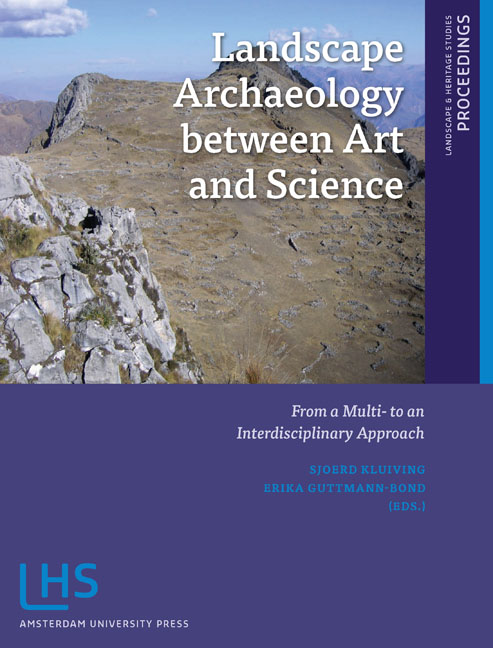Book contents
- Frontmatter
- Contents
- Preface
- Introduction: LAC2010: First International Landscape Archaeology Conference
- THEME 1 HOW DID LANDSCAPE CHANGE?
- THEME II IMPROVING TEMPORAL, CHRONOLOGICAL AND TRANSFORMATIONAL FRAMEWORKS
- THEME III LINKING LANDSCAPES OF LOWLANDS TO MOUNTAINOUS AREAS
- THEME IV APPLYING CONCEPTS OF SCALE
- THEME V NEW DIRECTIONS IN DIGITAL PROSPECTION AND MODELLING TECHNIQUES
- THEME VI HOW WILL LANDSCAPE ARCHAEOLOGY DEVELOP IN THE FUTURE?
- Miscellaneous Endmatter
1.2 - Irrigation and landscape: An interdisciplinary approach
- Frontmatter
- Contents
- Preface
- Introduction: LAC2010: First International Landscape Archaeology Conference
- THEME 1 HOW DID LANDSCAPE CHANGE?
- THEME II IMPROVING TEMPORAL, CHRONOLOGICAL AND TRANSFORMATIONAL FRAMEWORKS
- THEME III LINKING LANDSCAPES OF LOWLANDS TO MOUNTAINOUS AREAS
- THEME IV APPLYING CONCEPTS OF SCALE
- THEME V NEW DIRECTIONS IN DIGITAL PROSPECTION AND MODELLING TECHNIQUES
- THEME VI HOW WILL LANDSCAPE ARCHAEOLOGY DEVELOP IN THE FUTURE?
- Miscellaneous Endmatter
Summary
ABSTRACT
Studying irrigation history is studying the history of civilisation in dry areas where the natural environment and water infrastructure are closely connected. Yet, surprisingly little is known about the ways irrigation provided the material base for civilisations to prosper. Our knowledge how irrigation developed as interplay between hydraulic and humans is limited, presumably because that kind of knowledge is highly interdisciplinary in nature. Several aspects of water use in irrigation systems need to be explored, including timing and distribution, in order to study how water fluxes on different time scales could be incorporated in archaeological research. This paper discusses irrigation in the Zerqa triangle in the Jordan Valley where water tapped from the Zerqa River was transported to the fields through open canals under gravity. The settlement patterns found in the valley suggest close connections to the canal system from the Iron Age onwards. Physical aspects of the irrigated landscape will be explored by basic hydrological and hydraulic modelling.
KEYWORDS
irrigation, Jordan, explorative modelling, water management
INTRODUCTION
A most fascinating aspect of irrigation is the close connection between civilisation and the natural environment in which water infrastructure acts as interplay. Many civilisations of the past have used irrigation to feed their population. Intensified production provided a relatively secure food source for a larger population as it enabled the peasant population to produce a surplus to support the non-peasant population. Food security enabled development of city kingdoms in many regions: Mesopotamia, Egypt, the Indus-valley, China, Mexico and (coastal) Peru (Scarborough 2003). Because of the importance of irrigation, it has been well studied. The well-known Hydraulic Hypothesis is based on manipulation of water from larger streams for irrigating areas without reliable rainfall. Despite this valuable research, what has been stated by one author more than 25 years ago is still a valid comment. ‘Much of the archaeological literature on irrigation canals merely notes their presence at a certain period(s) and records their association with sites. It may describe or even classify the main features of an irrigation system […] but does not fully elucidate the technology, hydraulics or hydrology of the canals. Even where excavations into canals have been carried out, the researchers have not used their data to its full potential […].’ (Farrington 1980).
Information
- Type
- Chapter
- Information
- Landscape Archaeology between Art and ScienceFrom a Multi- to an Interdisciplinary Approach, pp. 45 - 58Publisher: Amsterdam University PressPrint publication year: 2012
Accessibility standard: Unknown
Why this information is here
This section outlines the accessibility features of this content - including support for screen readers, full keyboard navigation and high-contrast display options. This may not be relevant for you.Accessibility Information
- 2
- Cited by
